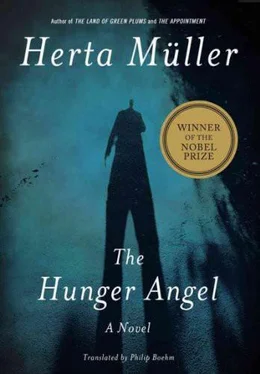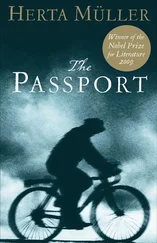Carrying the blocks involved a long balancing act, forty meters from the press to the drying area. The rows were never even, because each person had his own way of balancing and positioning his block. Also because the blocks weren’t set down in any order—some were placed in front, some in back, and some in the middle of a row, either to replace a ruined block or to use space that had been overlooked the previous day.
The freshly pressed mass weighed ten kilograms and was crumbly like wet sand. Carrying the board in front of you required nimble footwork—you had to coordinate your shoulders, elbows, hips, stomach, and knees with every step. The ten kilos weren’t yet a cinder block, and you couldn’t let them know you were carrying them. You had to trick them by rocking evenly back and forth, so the material wouldn’t wobble, and then let it slide off in one move at the drying area. Everything had to happen quickly and evenly, so that the new block made a smooth landing, scared but not jolted. For this you needed to squat, bending your knees until the board was under your chin, then spread your elbows like wings and let the block slip off just right. That was the only way you could place it close to the next block without damaging the edges of either. One false move and the block would collapse like so much dirt.
Carrying the blocks, and especially placing them, put a strain on your face as well. You had to keep your tongue straight and your eyes fixed squarely ahead. If anything went wrong you couldn’t even curse in anger. After a cinder-block shift, our eyes and lips were as stiff and square as the blocks. And on top of this we had the cement to cope with. The cement ran away, it flew through the air. More cement stuck to our bodies and to the drum and to the press than got mixed into the bricks. To press the cinder blocks you first set your board in the mold. Then you shoveled some mix into the form and pulled the lever. Then you pulled the lever again to raise both the board and the new block. After that you took the board and carried it off to the drying area, with nimble footwork and without losing your balance.
Cinder blocks were pressed day and night. In the mornings the mold was still cool and moist from the dew, your feet were still light, the sun had yet to hit the drying area. But it was already blazing on the peaks of the slag heaps, and by midday the heat was overpowering. Your feet lost their even gait, your knees shook, every nerve in your calves simmered. Your fingers were numb. You could no longer keep your tongue straight while placing the blocks. There was a lot of waste, and a lot of beating. In the evening a spotlight cast a beam of harsh light on the scene. Moths twirled around, and the mixing drum and the press loomed in the light like machines covered with fur. The moths weren’t drawn only to the light. The moist smell of the mix attracted them, like night-blooming flowers. They settled on the blocks that were drying, tapping with their threadlike legs and feeding tubes, even though much of the area was only half-lit. They also settled on the block you were carrying and distracted you from your balancing act. You could see the little hairs on their heads, the decorative rings on their abdomens, and you could hear their wings rustling, as though the block were alive. Occasionally two or three appeared at once and sat there as though they’d hatched out of the block itself. As though the wet mix on the board were not made of slag, cement, and lime slurry but was a square lump of larvae from which the moths emerged. They let themselves be carried from the press to the drying area, out of the spotlight into the layered shadows. The shadows were crooked and dangerous, they deformed the outlines of the blocks and distorted the rows. The block on its board no longer knew what it looked like. And you felt unsure, afraid you might mistake the edges of the shadows for the edges of the blocks. The flickering slag heaps a little way off added to the confusion. They glowed in countless places with yellow eyes, like nocturnal animals that create their own light, illuminating or burning off their lack of sleep. The slag heaps’ glowing eyes smelled sharply of sulfur.
Toward morning it turned cool, a milk-glass sky. Your feet felt lighter, at least in your head, because the shift was near its end and you wanted to forget how tired you were. The floodlight was tired, too, overcast and pale. The blue air settled evenly on each row and every block of our surreal military cemetery. A quiet justice unfolded, the only one that existed here.
The cinder blocks had it good, our dead had neither rows nor stones. But you couldn’t think about that, otherwise you wouldn’t be able to balance your load for several days or nights. If you thought about that even a little there would be a lot of waste, and a lot of beating.
The gullible bottle and the skeptical one
It was the skinandbones time, the eternity of cabbage soup. Kapusta when you get up in the morning, kapusta after roll call in the evening. KAPUSTA means cabbage in Russian, and cabbage soup in Russian means soup that often has no cabbage at all. If you take away the Russian and the soup, kapusta is just a word made of two things that have nothing in common—except this word. CAP is Romanian for head, and PUSTA is the Great Hungarian Plain. The camp is as Russian as the cabbage soup, but we think these things up in German. Nonsense like that is supposed to show we’re still clever. But no matter what you do with it, KAPUSTA doesn’t work as a hunger word. Hunger words make up a map, but instead of reciting countries in your head you list names of food. Wedding soup, mincemeat, spare ribs, pig’s knuckles, roast hare, liver dumplings, haunch of venison, hasenpfeffer, and so on.
All hunger words are also eating words, you picture the food in front of your eyes and feel the taste in your mouth. Hunger words, or eating words, feed your imagination. They eat themselves, and they like what they eat. You never get full, but at least you’re there for the meal. Every person with chronic hunger has his preferred eating words, some rare, some common, and some in constant use. Each person thinks a different word tastes best. Orach didn’t work as an eating word any more than kapusta, because we actually ate it. Had to eat it.
I believe that in hunger there is no difference between blindness and sight, blind hunger sees food best. There are silent hunger words and loud ones, just as hunger has its secret side and its public side. Hunger words, or eating words, dominate every conversation, but even so, you’re still alone. Everyone eats his words by himself although we’re all eating together. There’s no thought for the hunger of others, you can’t hunger together. Cabbage soup was our main food, but it mainly took the meat from our bones and the sanity from our minds. The hunger angel ran around in hysterics. He lost all proportion, growing more in a single day than grass in an entire summer or snow in an entire winter. Perhaps as much as a tall, pointed tree grows in its entire life. It seems to me the hunger angel didn’t just grow in size but also in number. He provided each of us with our own individual agony, and yet we were all alike. Because in the trinity of skin, bones, and brown water, men and women lose all difference, and lose all sexual drive. Of course you go on saying HE or SHE but that’s merely a grammatical holdover. Half-starved humans are really neither masculine nor feminine but genderless, like objects.
No matter where I was, in my bunk or between the barracks, at the yama on a shift or with Kobelian on the steppe, near the cooling tower, or washing up in the banya, or going door-to-door—everything I did was hungry. Everything matched the magnitude of my hunger in length, width, height, and color. Between the sky overhead and the dust of the earth, every place smelled of a different food. The main street of the camp smelled like caramel, the entrance to the camp like freshly baked bread, crossing the street to the factory smelled like warm apricots, the wooden fence of the factory like candied nuts, the factory gate like scrambled eggs, the yama like stewed peppers, the slag heaps like tomato soup, the cooling tower like roasted eggplant, the labyrinth of steaming pipes like strudel with vanilla sauce. The lumps of tar in the weeds smelled like quince compote and the coke ovens like cantaloupe. It was magic and it was agony. Even the wind fed the hunger, spinning food we could literally see.
Читать дальше












